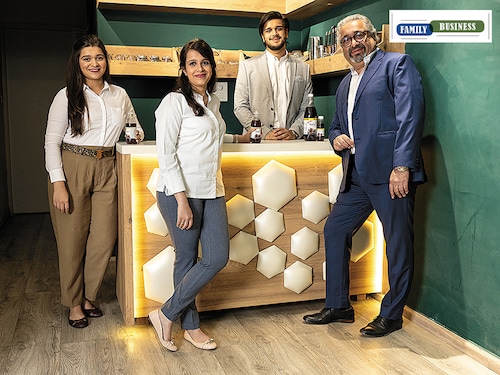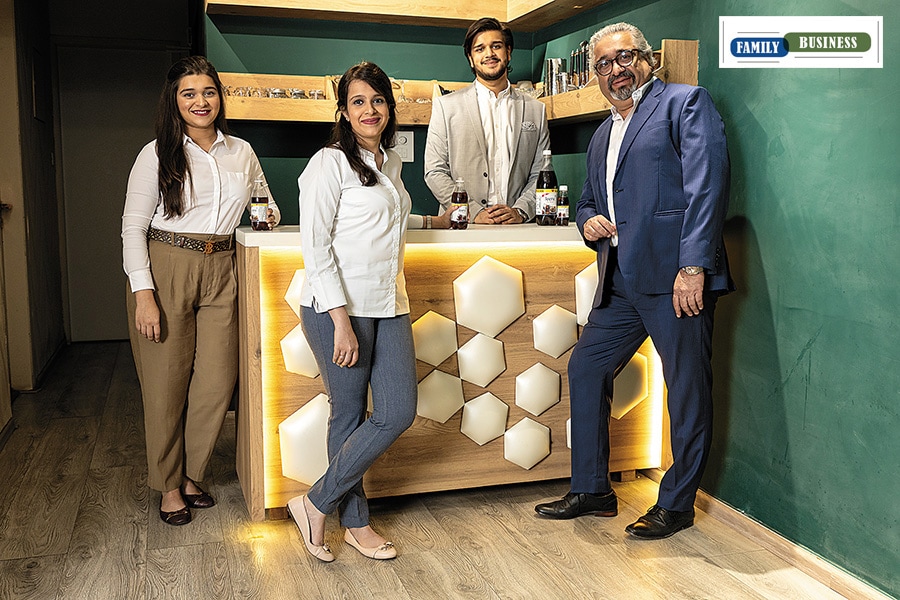The Sehgals: Spicing up the beverage space
The Sehgals created a brand out of a jeera masala drink. The next-gen is taking Jeeru pan-India


 Rajeev Sehgal (extreme right) with daughters Vishaka (extreme left) and Ankita, and son Dishank. Competition from multinationals does not worry the family
Rajeev Sehgal (extreme right) with daughters Vishaka (extreme left) and Ankita, and son Dishank. Competition from multinationals does not worry the family
Image: Arpit Jain for Forbes India
Ankita Sehgal is candid about her disastrous professional debut in 2013. The eldest daughter of Rajeev Sehgal, the first generation entrepreneur who started an apple juice-based fizzy masala drink Jeeru in 2008, initially wanted to become a print journalist. Joining the family business was not even a remote possibility for the 24-year-old, who didn’t find Jeeru cool as a brand name. What took the fizz out of her determination to become a scribe, though, was a ‘reality check’ by her father. An incisive question—how many women occupy top positions in print journalism—turned out to be an eye-opener. Joining dad and his world of jeera masala drinks made more sense.
In April, when Ankita joined the family-owned Xotik Frujus, a sultry Mumbai and a pint-sized office welcomed her. “The office space was so tiny that barely six people could fit into it,” she recalls. Conducting sales meetings with 30 to 40 people was a tough task. The business too was of modest scale—some ₹10-12 crore—largely unorganised, and had its own share of the blues. Galvanising a sales team to sell Jeeru, and making a brand out of it was not easy. A jeera masala drink was an alien product for modern retail stores, and the product lacked swag.
The young entrepreneur persisted. Attending office every day for a couple of hours was giving her a good hang of the business. Growth in confidence—which stemmed from a successful, and modest, incentive programme rolled out for the sales team, which included daily grocery items such as sugar and cooking oil—made her bold enough to make daring moves. And she dared big time quite early in her stint by inking a ‘costly’ deal with one of the big modern retail chains. Though the idea was to find a shelf for Jeeru and take it to the right place to grab eyeballs and sales, it did prove costly. “My first deal in modern retail was the most disastrous one,” she recalls.
What helped Ankita bounce back was the way her father handled the entire issue. “He didn’t make it look like a failure,” she says. He portrayed it as Jeeru’s first valiant move to make inroads into modern retail. Within two years, she points out, Jeeru was contributing over 11 percent of beverage sales for Future Retail. “My dad always gave us a free hand and the courage to make mistakes and learn,” she says. A year after Ankita joined the business, her younger sister Vishaka followed suit, and handled the general trade. Brother Dishank was the last one to join and diversified the business by launching Xotik cafes.
Sehgal’s confidence in his children has paid off. From undertaking sales force automation to roping in marketing professionals, from charting out aggressive growth plans to fanning out across the country, and from ending ‘jugaad’ marketing and earmarking a decent amount for marketing and sales, the Sehgals have made a brand out of a commodity. While the organised market for jeera masala drink stands at ₹700 crore, the Sehgals claim to be the biggest player. Xotik Frujus gets over 80 percent of revenue from flagship Jeeru which comes in six stock keeping units (SKUs) ranging from ₹10 to ₹90.
From ₹10 crore in 2010-11, Xotik Frujus posted a revenue of ₹72.95 crore in the March-ended fiscal 2019-20. A little over a fifth of sales come from modern retail chains such as Walmart, Big Bazaar, and DMart. From being a Mumbai- and Surat-centric product, Jeeru is now a pan-India brand, and has a presence at airports with a premimum variant of the drink priced at ₹100. Recently, it roped in 82.5 Communications, a sister agency of Ogilvy, as its advertising agency.
The Sehgals, reckon food and beverage experts, have done a splendid job in building a brand out of jeera masala drinks. It is usually observed that ethnic beverages sell well in artisanal form and that is why it is rare to see a single brand-single variant combination to grow to a decent scale, says Jaspal Sabharwal, a private equity veteran and CEO of TagTaste, a sensory analytics and product development platform for food and beverages. Jeeru, he adds, has defied this trend, and the reasons are not hard to fathom. First, the Sehgals spotted a trend that was too simple for MNCs to spot. “Normal is always ‘boring’ for legacy businesses but making normal ‘special’ is where the scale is and Jeeru’s founders were quick to spot that,” says Sabharwal.
Second, it is not easy to develop a formulation for products where the core ingredient has a massive familiarity with consumers, and that makes acceptability of the product extremely complex. Third, the company did the right thing by initially focusing on limited geography clusters. “It enabled them to control their burn and at the same time they kept improving their product,” says Sabharwal. Taking the next leap—from a revenue of ₹70 crore-something to ₹200 crore—will likely happen over the next three to four years.
The journey for the first-generation entrepreneur was not easy. Sehgal, whose father worked in the railways, never wanted a 9 to 5 job after completing his master’s in sales and marketing. Circumstances forced him to work for over seven years. The idea was to save money to start his own venture. And it did happen in 1998, when Sehgal started a packaged drinking water brand Macblue in Mumbai.
Over the next decade, he kept struggling with his brand. Reason: Apart from the big boys of packaged water—Bisleri, Aquafina and Kinley—there was a sea of local brands that played on price. “It was not possible to make a brand out of Macblue,” recalls Sehgal, who decided to diversify by entering into contract manufacturing for Bisleri and Orangina, a carbonated beverage brand made by French firm Orangina Schweppes, which was later acquired by Suntory Holdings of Japan. In 2008, Sehgal also rolled out his jeera masala offering Jeeru.
Why a jeera masala drink? Sehgal explains. Colas, mango and orange drinks were highly competitive, and the space was crowded. Sehgal was looking for a beverage category that was huge but without any leader brand. Jeera masala, which was a large cottage, unorganised industry with thousands of sellers across the country in variant forms, was virgin territory offering massive headroom for growth. Though the decision to enter uncharted territory was easy, the resistance was massive.
The first major challenge came from local players who played price warriors. Most of them didn’t pay tax, compromised on quality, rolled out unhygienic products, and prospered on retail push by offering heavy margins. So a ₹12 bottle of Jeeru was fighting against a ₹4 bottle of a local player. What was interesting was that all local players bought Bacardi Breezer glass bottles from scrap dealers and sold jeera masala in them. Realising that doing too many things was not yielding results, Sehgal decided to play a focussed game. From 2011, he stopped contract manufacturing, shifted to Daman and opened a manufacturing plant with imported machinery, and invested in product development.
The next big challenge was to find distributors. Despite having a quality product, there were no takers. Reason: Sehgal didn’t want to push sales via the margin route. “The idea was to create a brand and not to sell a commodity,” he recalls. What he did next was innovative marketing: Selling Jeeru in cans. The gambit paid off. As Jeeru started grabbing eyeballs and sales, distributors started showing interest. There has been no looking back since then. While Eastern and Western India are its two big markets—including Maharashtra, Gujarat and Rajasthan, it rolled out some cola and juice products to enter into Northern and Southern India where jeera masala was not popular. In fact, the brand now gets exported to the UK, Middle East and Africa.
Back home, the sales have continued their impressive march despite Covid-19. While in March, Jeeru numbers were down by 80 percent compared to the same period last year, in April, they were down by 40 percent. After two months there has been a remarkable uptick, as June saw a jump of 35 percent, and in August, the company has doubled what it did last year during the same month. “When beverage makers were left out in the cold, we invested in marketing,” says Sehgal. Jeeru, he underlines, being positioned as a digestive drink came as a blessing in disguise. “We continue to maintain our pole position,” says Sehgal.
The challenge for the leader now is the Cola Big Boys. With Coke and Pepsi pushing jeera masala and local variants of drinks under their respective brands RimZim and Duke’s—Sehgal might find the going tough. Sabharwal of TagTaste reckons the MNC biggies won’t pose any fight. Reason: They are so used to 80 percent-plus gross margins at concentrate level that they just can’t realign their cost structures to make a success out of such categories. Jeeru’s big ask, he contends, would be to stay nimble and not do things in a hurry. “There will be an urge to expand the product portfolio and if they do, it will be a huge mistake,” he says. Keeping on making ‘normal’ more exciting and relevant in terms of product improvisation, packaging, and consumer connect should be the mantra for the Sehgals, he adds.
Sehgal is keeping his focus intact. “For us, jeera masala is everything. For cola majors, it is one of many things,” he says, adding that the belligerence from MNCs gets blunted due to their vast product offerings. Though venture capitalists and private equities have tried to invest in the company, Sehgal has not taken the bait. With outside money, he says, comes interference. “Our cash flow is good and we do things at our own pace,” he says. “This is the right approach.”
Ankita, too, has found the right ‘space.’ During her stint, while pursuing an MBA in family business, she noticed something jarring: Only 15 girls in a class of 120. At that time, “it made me wonder if I was at the right place,” she recalls. After seven years in the family business, she has found the answer. “I am among the very few in the right place.”
First Published: Sep 24, 2020, 10:05
Subscribe Now